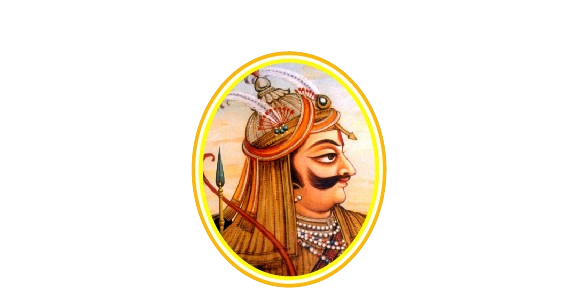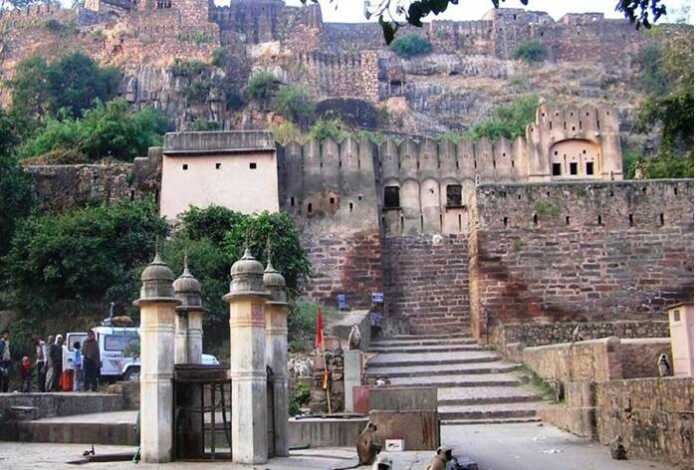Ranthambhor Fort was founded in 944 A.D. by Chauhan Rajputs. On account of its strategic position it played an important part in the history of Northern India.
Ranthambhor became the centre of Chauhan power after the defeat and death of Prithviraj Chauhan of Ajmer in 1192 A.D. Govindraja, the son and successor of Prithviraj established himself at Ranthambhor Fort by the close of 12th century.
Vallahna Deva (Balhana) the son of Govindaraja succeeded the latter at the Ranthambhor throne. This Chauhan prince seems to have not only kept up the independence of the Ranthambhor but even held away over certain adjoining territories.[1]
In an inscription of V. S. 1272 found at Manglana (Jodhpur), one Jaitra Simha is said to have accepted the suzerainty of Vallahnadeva of Ranthambhor; though ‘Suratrana Lititimishi of Jognipura’ (Sultan Iltutmish of Delhi) too is recognised as an over-lord.[2]
It seems probably that the firm establishment of Vallahna Deva at Ranthambhor and his expansionist activities might have induced Iltutmish to lead an expedition against him in 1226 A.D.[3]
Turk rulers of Delhi invaded this fort many times. When they launched any conquest of Deccan, they had to cross the Chambal valley over which the Chauhans of Ranthambhor enjoyed an effective control.
According to Minhaj-us-Siraj, the fort fell into the hands of Sultan Iltutmish after the siege of a few months.[4]
Ranthambhor was not, however, annexed even after 1226 A.D. The Chauhans asserted their independence after the death of Iltutmish. Vagbhatta, son of Vallahana Deva, with the help of the Kharaparas (Khakars) besieged Ranthambhor and compelled the Muslims to vacate the fort.[5]
This restoration of the Ranthambhor fort to the Chauhans took place during the weak rule of Sultan Ruknuddin Feroz.
Sultan Raziah made attempts to regain the fort but could not succeed. Vagbhatta strengthened his control over the fort. Ranthambhor enjoyed independence at least upto the accessions[6] of Sultan Nasir-ud-din Mahmud.
Vagbhatt’s successor, Jaitrasimha, in an inscription found near Kota, is recorded to have repeatedly defeated the Paramaras of Malwa.[7]
This growing power of the Ranthambhor Chauhans, compelled Ulugh Khan (Balban) as early as 1247-48 A.D. to send an armed expedition which failed to do anything. Balban in 1253 A.D. (when he held the Iqta of Nagaur) led another campaign against the Ranthambhor and its adjacent territories, but he had to retreat. A third expedition was sent by Ulugh Khan in 1258 A.D. under Malik-un-Nawab Aibak.[8]
This expedition also like the earlier ones may be supposed to be a complete failure since the Muslim chronicler hesitates to furnish the details about the fate of the expedition. It seems that the Rajputs took full advantage of the repeated failure of the Muhammad an invasions. During his short rule of six years, Sultan Jalaluddin Feroz Khalji made two attempts to subjugate the fortress of Ranthambhor, but as would be seen presently he failed in both his attempts.
Sultan Allauddin Khalji decided at the advice of Qazi Alaul-Mulk[9] to reduce the adjoining Rajput territories. Ranthambhor, a stronghold noted for its Muslim opposition and being very near to Delhi, caught the immediate attention of the Sultan in pursuit of his expansionist policy. Moreover, the strategic importance of the fortress as well as the failure in earlier attempts made by his predecessors, notably Sultan Jalaluddin, also partly accounted for Allauddin’s invasion over the fort of Ranthambhor.
Hammir Deo had sheltered the neo-mussalmans[10] under the leadership of Muhammad Shah, following the mutiny at Jalor. This might have been the immediate reason as stated by Hammir Mahakavya [11] and Isami.[12] Barani[13] summaries the event and states that the Sultan took Ranthambhor with great blood shed and difficulty.
Allauddin Khalji slew Hammir Deo and all neo-musalmans, who had taken shelter in Ranthambhor.
After its fall, Ranthambhor was entrusted to Ulugh Khan and Allauddin Khalji himself returned to Delhi,[14] With this ended the Ranthambhor line of the Chauhans, who had successfully resisted the Sultanate’s incursions during the whole of the thirteenth century.
REFERENCES
[1] M. S. Ahluwalia, Ranthambhor During The Thirteenth Century, Proceedings of Rajasthan History Congress, pp. 110-112.
[2] I Ant. xvi, p 86. In another gra. t (E, I. xii, pp. 223-4) a prince named Chabara Deo boasts of his Chauhana descent and appears to be ruling at Ranthambhor. The name, however, does not appear in Hammir Mahakavya (Cited by Habibullah, p. 110, fn. 78),
[3] T. Nas, Text, p. 172.
[4] Ibid., p. 172.
[5] Hammir Mahakavya, I. Ant. 1879, pp. 63-4; Compare Minhaj, Trs. Elliot, II p. 334.
[6] Hammir Mahakavya, I, Ant. 1879, p. 64.
[7] Cited by Ojha, Raj. I, p. 203.
[8] M. S. Ahluwalia, Ranthambhor During The Thirteenth Century, Proceedings of Rajasthan History Congress, pp. 110-112.
[9] Barani, Text, p.269 and Elliot, III. p. 171,
[10] Muhammad Shah, the Mongol chief was the leader of the neo-musalmans, converted into Islamic faith during Jalaluddin’s reign. For details of muting see, Barani, Text, p. 253 and Isami, Text, pp. 244-55.
[11] Hammir Mahakavya, p. 67.
[12] Isami. Text, pp. 254-55.
[13] Barani, Text, pp. 272-73, Trs., pp. 178-79.
[14] Barani, Text., p. 283.




